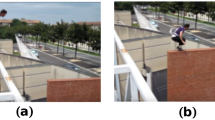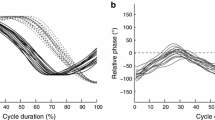Abstract
In this paper, the hypothesis that multijoint control strategies are transferred between similar tasks was tested. To test this hypothesis, we studied the take-off phase of two types of backward somersault dives: one while translating backwards (Back), the other while translating forward (Reverse). An experimentally based dynamic model of the musculoskeletal system was employed to simulate the measured kinematics and reaction force data and to study the sensitivity of take-off performance to initial kinematic conditions. It was found that the horizontal velocity of the total body center of mass (CM) was most sensitive to modifications in the initial shank conditions. Consequently, the initial shank kinematics of the Back dive was modified in the optimization procedure while maintaining the joint coordination of the Back in order to generate the CM trajectory and reaction forces of a Reverse. Similarly, the initial shank kinematics of the Reverse dive was modified to simulate the CM trajectory and reaction force of the Back. It was found that small modifications in the initial shank kinematics led to change in direction of horizontal CM velocity at take-off; resulting in a switch from Back to Reverse and vice versa. In both cases, the simulated momentum conditions at departure and the bimodal shape of the reaction force-time curve were consistent with those experimentally observed. The results of this study support the hypothesis that transfer of control strategies between similar tasks is a viable option in multijoint control. This transfer of control strategy is explained using a hierarchical model of the motion control system.
Similar content being viewed by others
References
Alexander RM (1991) Energy-saving mechanisms in walking and running. J Exp Biol 160:55–69
Anderson FC et al (1995) Application of high-performance computing to numerical simulation of human movement. J Biomech Eng 117(1):155–157
Arabyan A, Tsai D (1998) A distributed control model for the air-righting reflex of a cat. Biol Cybern 79(5):393–401
Bernstein N (1967) The co-ordination and regulation of movements. Pergamon Press, Oxford
deLeva PJ (1996) Adjustment to Zatsiorsky–Seluyanov’s segment inertia parameters. J Biomech 29(9):1223–1230
Enoka RM (1988) Load- and skill-related changes in segmental contributions to a weightlifting movement. Med Sci Sports Exerc 20(2):178–187
Flashner H et al (1987) Modeling of control and learning in a stepping motion. Biol Cybern 55(6):387–396
Flashner H et al (1988) Fitting mathematical functions to joint kinematics during stepping: implications for motor control. Biol Cybern 58(2):91–99
Gerritsen KG et al (1995) Direct dynamics simulation of the impact phase in heel-toe running. J Biomech 28(6):661–668
Greenwood DT (1988) Principles of dynamics. Prentice-Hall, NJ
Gruber K et al (1998) A comparative study of impact dynamics: wobbling mass model versus rigid body models. J Biomech 31(5):439–444
Guler HC et al (1998) A viscoelastic sphere model for the representation of plantar soft tissue during simulations. J Biomech 31(9):847–853
Hatze H (1981) A comprehensive model for human motion simulation and its application to the take-off phase of the long jump. J Biomech 14(3):135–142
Inman VT et al (1981) Human Walking. Williams and Wilkins, Baltimore, MD
Ju MS, Mansour JM (1988) Simulation of the double limb support phase of human gait. J Biomech Eng 110(3):223–229
Mathiyakom W et al (2005a) Lower extremity control and dynamics during backward angular impulse generation in backward translating tasks. Exp Brain Res: 1–12
Mathiyakom W et al (2005b) Lower extremity control and dynamics during backward angular impulse generation in forward translating tasks. J Biomech
Mathiyakom W et al (2005c) Modifying center of mass trajectory during sit-to-stand tasks redistributes the mechanical demand across the lower extremity joints. J Clin Biomech 20:105–111
McNitt-Gray JL et al (2001) Mechanical demand and multijoint control during landing depend on orientation of the body segments relative to the reaction force. J Biomech 34(11):1471–1482
Miller D, Hennig E, Pizzimenti M, Jones I, Nelson R (1989) Kinetic and kinematic characteristics of 10-m platform performance of elite divers: I. back takeoffs. Int J Sport Biomech 5:60–88
Miller DI (2000). Springboard and platform diving. In: Zatsiorsky VM, Osney Md (eds). Biomechanics in sport: performance enhancement and injury prevention. Blackwell, Oxford, pp 326–348
Neptune RR (1999) Optimization algorithm performance in determining optimal controls in human movement analyses. J Biomech Eng 121(2):249–252
Pandy MG et al (1992) A parameter optimization approach for the optimal control of large- scale musculoskeletal systems. J Biomech Eng 114(4):450–460
Prilutsky BI, Zatsiorsky VM (1994) Tendon action of two-joint muscles: transfer of mechanical energy between joints during jumping, landing, and running. J Biomech 27(1):25–34
Raibert MH (1986) Legged robots that balance. MIT, Cambridge
Requejo PS et al (2002) An approach for developing an experimentally based model for simulating flight-phase dynamics. Biol Cybern 87(4):289–300
Requejo PS et al (2004) Modification of landing conditions at contact via flight phase control. Biol Cybern 90(5):327–336
Schmidt RA (2003) Motor schema theory after 27 years: reflections and implications for a new theory. Res Q Exerc Sport 74(4):366–375
Shea CH, Wulf G (2005) Schema theory: a critical appraisal and reevaluation. J Mot Behav 37(2):85–101
Woltring H (1986) A fortran package for genereralized cross-validatory spline smoothing and differentiation. Adv Eng Soft 8(2):104–113
Zajac FE (1993) Muscle coordination of movement: a perspective. J Biomech 26(Suppl 1):109–124
Zatsiorsky V, Seluyanov V (1983) Estimation of the mass and inertia characteristics of the human body by means of the best predictive regression equations. Biomechanics IX-B. Champaign, IL, Human Kinetics, pp 233–239
Author information
Authors and Affiliations
Corresponding author
Rights and permissions
About this article
Cite this article
McNitt-Gray, J.L., Requejo, P.S. & Flashner, H. Multijoint Control Strategies Transfer Between Tasks. Biol Cybern 94, 501–510 (2006). https://doi.org/10.1007/s00422-006-0063-y
Received:
Accepted:
Published:
Issue Date:
DOI: https://doi.org/10.1007/s00422-006-0063-y




